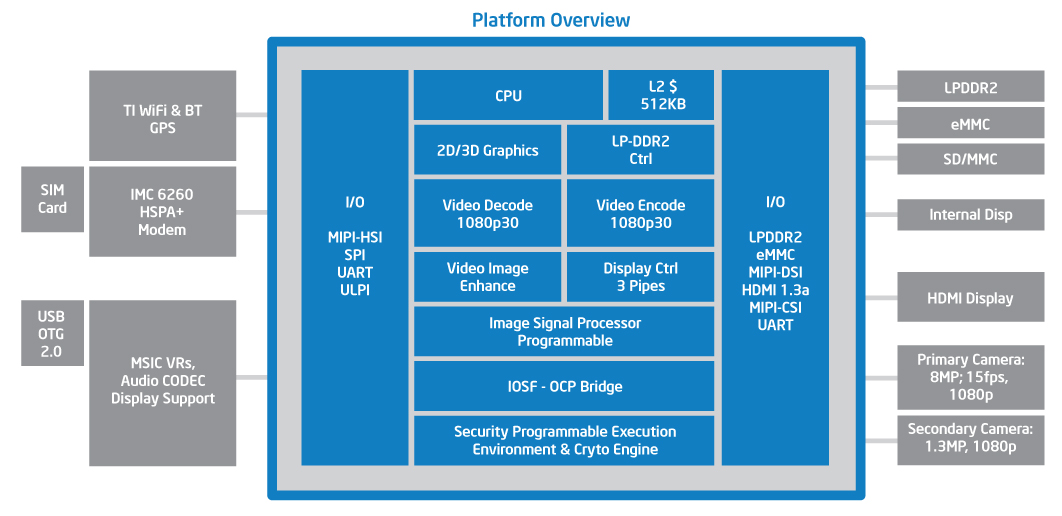Intel’s first partners and smartphone was uncovered earlier this weeks at CES, which also means the first details on the Medfield platform is here. The first benchmarks have been released, and ot looks like Intel is standing up well against current smartphones and system processors.
After many years Intel has finally managed to get into the smartphone market and Medfield that has been in the new for some time, without any real specifications. Medfield is Intel’s first real SoC (System-on-a-Chip) or system processor, where all components are found inside the same package. The advantage with this over previous Intel solutions is mainly lower energy consumption, but also smaller imprint, which is just as important in the hunt for thinner and slimmer smartphones.
The first circuit in the Medfield platform is the system processor Penwell, dubbed Z2460. Penwell measures about 62mm², which is bigger than e,g, NVIDIA Tegra 2 at 49mm², smaller than 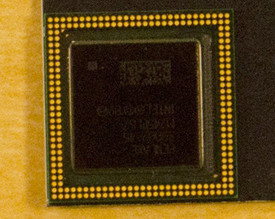 NVIDIA Tegra 3 at 80mm² and Apple A5 at ~110mm². Penwell consists of an Atom core at 1.3 GHz with 512 KB L2 cache, but sports 1.6GHz Turbo mode. Intel also brings HyperThreading for better performance in multithreaded applications. The graphics is supplied by a PowerVR SGX540 at 400 MHz, which is also found in Samsung Galaxy Nexus and TI OMAP 4430.
NVIDIA Tegra 3 at 80mm² and Apple A5 at ~110mm². Penwell consists of an Atom core at 1.3 GHz with 512 KB L2 cache, but sports 1.6GHz Turbo mode. Intel also brings HyperThreading for better performance in multithreaded applications. The graphics is supplied by a PowerVR SGX540 at 400 MHz, which is also found in Samsung Galaxy Nexus and TI OMAP 4430.
Despite farily dull specifications it turns out Medfield is quite fast compared to other smartphones. Medfield outperforms Apple iPhone 4S and Samsung Galaxy Nexus, despite iOS 5 and Android 4.0 with faster and more efficient browsers than Android 2.3 that Intel’s reference platform uses.
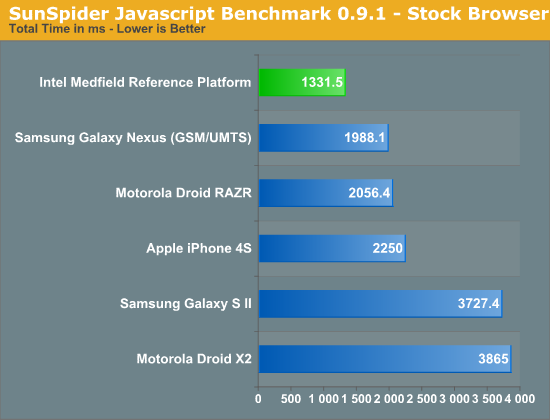
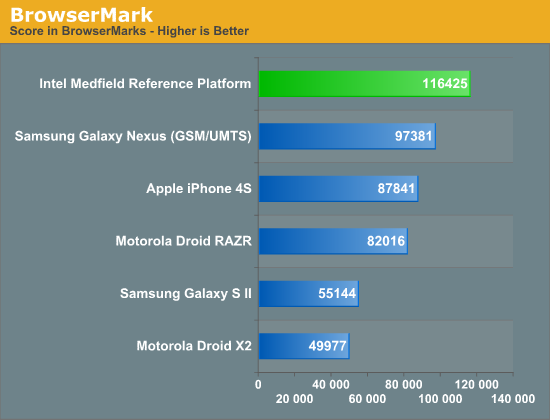
Intel says that Cortex-A9 is not a bad core, but is limited by the available memory bandwidth since this was not a key focus in the development. Intel offers a dual-channel memory bus at 64-bit (2x 32-bit), and in many cases ARM-based circuits has only one 32-bit bus that is also less efficiecnt than Intel’s solution.
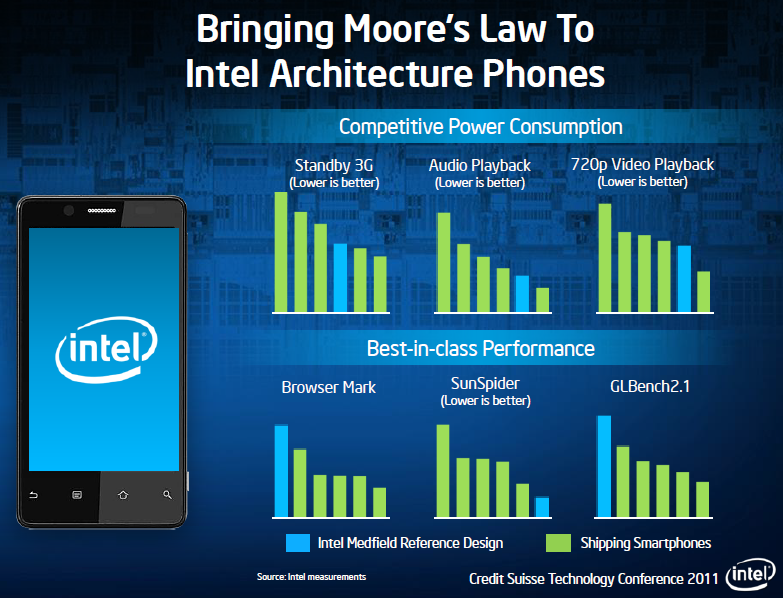
There are probably many who remember this slide from Intel. It has now been revealed which smartphones it is being compared to, and they are heavy weighs. The green pillars are Samsung Galaxy S II, LG Optimus 2X, iPhone 4S, HTC Sensation and Motorola Droid 3. The numbers for the energy consumption tests is with Intel’s own reference platform. The energy consumption of Medfield is neither bad nor good, but is on par with other smartphones like Samsung Galaxy S II and Apple iPhone 4S.
To reduce energy consumption Intel has worked hard on Medfield, and made changes to its manufacturing technology. Medfield builds on tailored 32nm technology: 32nm LP (Low-Power) that is designed for lower current leakage and lower energy consumption. The drawback with such a technology is that it does not scale to the same frequencies as other processes, which this should not be a problem since smartphones should not be clocked very high anyway. Lower current leakge is very important when a circuit is in idle mode, but also when only a some parts are used.
Medfield will be capable of decoding and encoding 1080p30 material with up to 50 Mb/s bitrates thanks to dedicated logic from Imagination Technologies, which also supplies the PowerVR SGX540 graphics circuit. Medfield also houses technology from recently acquired Silicon Hive, that supports camera sensors between 5 and 16 megapixels. This is the puzzle piece that makes Medfield capable of taking 15(!) 8 megapixel pictures per second, a function Intel calls Burst Capture.
Intel has more than Cortex-A9 to worry about in 2012
Even if we can safely say that Penwell and the Medfield platform looks impressive we should not forget one important detail. It is compared to much older system processors, nearly one year old. During the first half several new smartphones will appear sporting new systemprocessors. Many will continue to use ARM Cortex-A9 circuits, but Qualcomm will release its new Krait architecture in the form of several system processors that is already shipping to partners, and should be in retail about the same time as Intel-based smartphonen. Krait is expected to perform on the same level as Atom, but Cortex-A15 will be when the ARM front really kicks in.
 Qualcomm says Snapdragon S4 Krait will outperform Atom
Qualcomm says Snapdragon S4 Krait will outperform Atom
A15 will like A9 be an OoO design (Out-of-Order), but considerably broader with more resources than A9. A15 should outperform Atom and Krait, and with a dual-core version it is not much to discuss really. It is still uncertain if the first system processor with Cortex-A15 will reach the market the first half of this year, but most likely we will have to wait until late Fall and Winter.
Before the end of 2012 Intel will have a dual-core model coming, but also a new graphics circuit. Exactly which graphics circuit is not known, but most likely it is a PowerVR chip from Imagination Technologies more powerful than SGX540. Intel is also expected to release some form of system processor for smartphones in the lower segments.
Intel is finally becoming an actor on the smartphones market, and not just an aspiring such. The big question is if it can compete with ARM and its already strong partners that has a firm hold on the market. Intel very rarely fails at any venture, but there are exceptions. Even if the company looks to have many of the right ingredients to succeed, we can safely say it will not be easyy to break into this particular market.
Source: Anandtech












